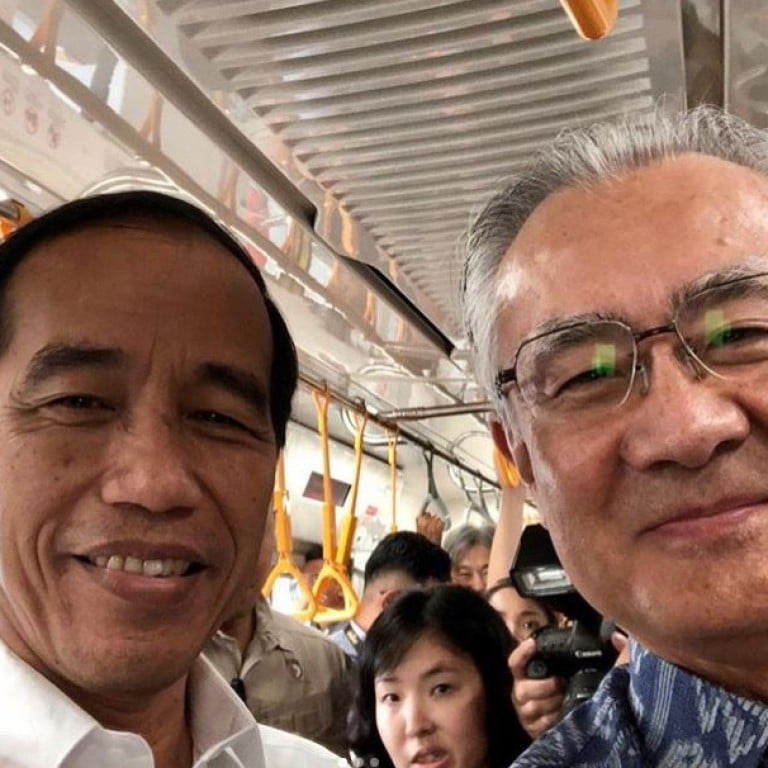
Japanese ambassador Masafumi Ishii wins Indonesians’ hearts one kawaii Instagram post at a time
- The 61-year-old has held the position since April 2017, and over the past year has been winning a steady following for his irreverent posts
- From posing like a duck to delighting in his meals, Ishii says his social media adventures help ‘bring diplomacy closer to the people’
Combining kawaii – cute in Japanese – poses, a batik top, and a veritable smorgasbord of Indonesian cuisines and matching poses has proved a winning combination. Ishii is the sort of person who mimes poultry before tucking into a meal of Balinese fried duck; little wonder the ambassador has more than 67,000 followers on Instagram, an increase of some 30,000 from just two months ago.
“I signed up for Instagram in March 2018 and started to post in October 2018. I wanted to post pictures of my daily activities in the hopes that more people in Indonesia would become interested in Japan. I usually brainstorm with my staff about what I should post. It’s a trial and error process to see what people find most interesting,” he said in an email interview with This Week in Asia.
Does he have a favourite dish? “I get that question a lot, but it’s difficult for me to choose just one because I like all the Indonesian dishes that I’ve tried. Usually, I tell my staff what I feel like having [rice or noodles and so on], and then they will decide on the menu. My staff makes a list of Indonesian dishes that I haven’t tried yet so that they can pick one from the list,” he said.
Ishii’s posts are carefully curated by him and his staff – and the photo compositions show their attention to detail and humour.
In one post, the ambassador is shown with a Sundanese food spread featuring a variety of vegetable dishes including tofu and mushrooms wrapped in a banana leaf and sayur asem, or vegetables in tamarind soup. He has posed holding a wayang golek, or rod puppet, and in apparent reference to previous comments that his lunches look hearty, writes that he “can eat a lot because most of it is vegetables”.
“I am trying to be a wayang golek puppet master,” Ishii adds.
Tirta Nugraha Mursitama, head of the international relations department at Bina Nusantara University, said Ishii had done a “good job, relatively, at bridging Indonesia’s and Japan’s interests. Japan-Indonesia relations are at a good level.”
Ishii isn’t a stranger to Indonesia, having visited the country of 256 million (and 171 million internet users) in his role as director of the Second Southeast Asia Division at Japan’s foreign affairs ministry.
The East Asian nation is one of Indonesia’s largest export markets, and in the first quarter of 2018 Japanese foreign direct investment in Indonesia was second only to Singapore at US$1.4 billion, according to figures released by the Indonesia Investment Coordinating Board.
Ishii also oversaw the 60th anniversary of Japan-Indonesia relations last year; the milestone saw the launch of a bilateral agreement in the form of Project 2045, which predicates the countries’ common interests based on their maritime influence.
Timed to coincide with the 100th anniversary of Indonesia’s independence, the project’s aims include fostering both countries’ economies “to rank among the top 5” in the world according to its executive summary.
“As two maritime democracies in the Indo-Pacific, Japan and Indonesia share strategic challenges and dreams in common, and through the joint efforts I believe that Japan and Indonesia will become each other’s best partner,” Ishii said.
He was also present at the launch of Jakarta’s mass rapid transit system in March 24, which was funded by a soft loan from the Japan International Cooperation Agency. In February, Indonesia secured a US$632.64 million soft loan from Japan for the second phase of the system’s construction work.
Like it did with Malaysia and Singapore, Japan occupied Indonesia during World War II. It was only in 1958 that the two countries formalised diplomatic relations following Japan’s signing of the 1951 Treaty of San Francisco and Tokyo began paying reparations over a period of 12 years to Jakarta.
Bilateral ties have remained stable, with the exception of anti-Japanese protests when then prime minister Kakuei Tanaka visited Jakarta in 1974. An Asean-wide poll commissioned by Japan’s foreign ministry in 2014 found Indonesians were more likely than others in the region to regard Japan as trustworthy and an important future partner.
Ishii, however, put it more succinctly. “[Social media] allows us to engage with the public in real time, which helps bring diplomacy closer to the people,” he said.
